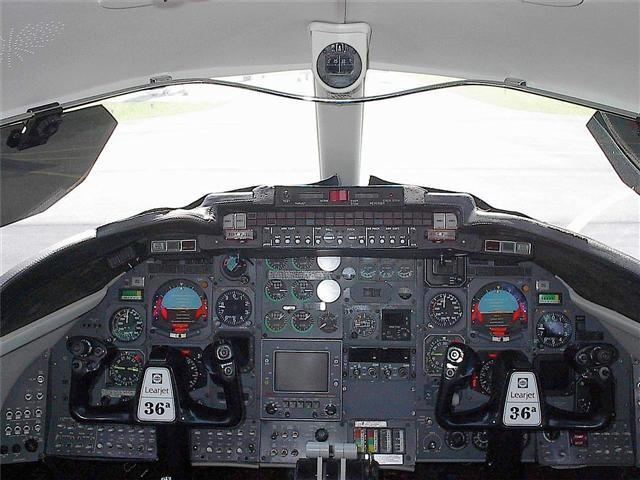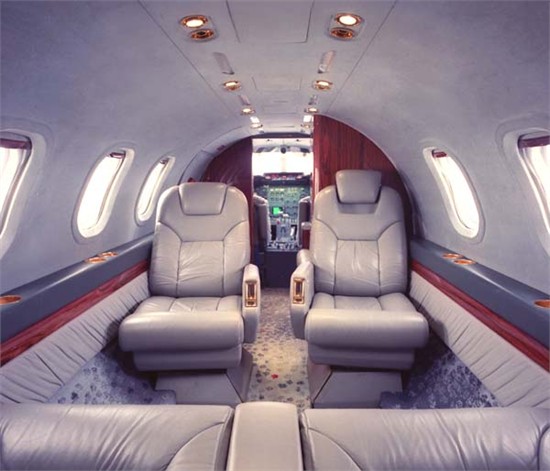


Aircraft Description
Background/History
The Learjet 36A represents a significant development in the long line of aircraft descended from Bill Lear’s original Lear 23, which first flew in October 1963. While all of the 20-series Learjets were powered by turbojet engines, the current generation of turbofan-powered Learjets began in August 1973 with the first flight of the Model 35. Equipped with a pair of Garrett AiResearch TFE 731 turbofans, the Learjet 35 began a new era of quiet, fuel-efficient operation in comparison to the turbojet aircraft of the previous decade. The 35 and 36 were certificated with the same maximum takeoff weight, but the two are configured for different missions. Of the two, the 36 is the long-range variant, with greater fuel capacity than the 35, but with seating limited to six passengers, while the 35 is optimized for eight passengers. Both the 35 and 36 were granted FAA certification in July 1974. The 35A and 36A were introduced in 1976 and feature an increase in MTOW to 18,300 lbs.
Power
The Learjet 36A is powered by a pair of AlliedSignal TFE 731-2-2B turbofans rated at 3,500 lbs. thrust each.
Avionics
Learjet 36A panels have evolved over the years from the analog displays of the early model years to the digital cockpits of later years. Recent-year 36A’s featured Collins nav/comm/ident radios in duplicate as standard equipment and offered as optional equipment a Collins EFIS package with right- and left-side primary flight displays and a large center multi-function display, color weather radar, and FMS.
Design Features
The Learjet 36A is a long-range, twin turbofan-powered business aircraft configured as a cantilever low-wing monoplane with a slight leading-edge sweep, cantilever T-tail, and retractable tricycle landing gear with two wheels on each main gear unit. The fuselage of the 36A is stretched 1.1 ft. beyond that of the model 25, which itself employed a 4.2 ft. stretch of the original model 23 fuselage. The wing retains the familiar wingtip tanks of earlier Learjets. The 36A offered a maximum takeoff weight of 18,300 lbs.
Accomodations
The Learjet 36A is optimized for long range missions, and so is arranged for six passengers rather than the eight passenger layout normally found in the Learjet 35A. A refreshment center is normally positioned along the port sidewall, while the rather small lavatory is located in the forward cabin on the starboard side, opposite the airstair door. The Learjet 36A utilizes the same fuselage cross-section as previous Lears, with a cabin height of 4.3 ft. and cabin width of 4.9 ft.
| General | Learjet 36A, LR-36A | |||
|---|---|---|---|---|
| Category | Jet < 20,000 lbs. | |||
| Years Aircraft Manufactured | 1976 – 1984 | |||
| Serial Number Range | 018 – 056 | |||
| Retail High Price | $1,975,000.00 / 1,549,782.50€ | |||
| Retail Low Price | $1,975,000.00 / 1,549,782.50€ | |||
| Characteristics | Learjet 36A, LR-36A | |||
| Seating | 2+5/10 | |||
| Wing Loading | 72.2 | |||
| Power Loading | 2.6 | |||
| Noise(EPNdB): Takeoff/Sideline/Approach | 83.9/91.4 | |||
| External Dimensions (ft) | Learjet 36A, LR-36A | |||
| External Length | 48.7 | |||
| External Height | 12.3 | |||
| External Span | 39.5 | |||
| Internal Dimensions (ft) | Learjet 36A, LR-36A | |||
| Internal Length (Overall/Net Height) | 10.8 | |||
| Internal Height | 4.3 | |||
| Internal Width (Max/Floor) | 4.9 | |||
| Baggage | Learjet 36A, LR-36A | |||
| External: Cu.Ft./Lb. | N/A | |||
| External: Cu.Ft./Lb. | N/A | |||
| Power | Learjet 36A, LR-36A | |||
| Engines | 2 Hon TFE731-2-2B | |||
| Output (lbs ea.)/Flat Rating | 3,500 | |||
| Inspection Interval | 4,200c | |||
| Data based on latest manufactured year | ||||



